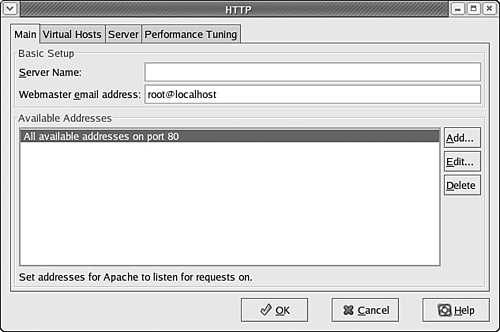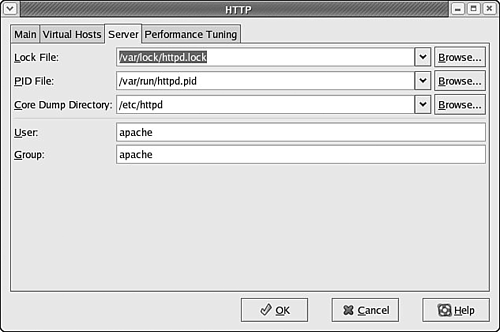Graphic Interface Configuration of Apache
| < Day Day Up > |
| Some of Apache's basic behavior can be configured using Red Hat's system-config-httpd, a GUI tool for the X Window System. This can provide an easy way to configure settings, such as Apache's user and group name, the location of PID and process lock files, or performance settings (such as the maximum number of connections), without manually editing configuration files. CAUTION If you use system-config-httpd, you shouldn't try to manually edit the httpd.conf file. Manual changes are overwritten by the GUI client if you again use system-config-httpd! Launch this client by using your X desktop panel's Server Settings' HTTP Server menu item or from the command line of an X terminal window, like this: $ system-config-httpd & After you press Enter, you're asked to type the root password. You then see the main client window shown in Figure 19.2. Figure 19.2. The system-config-httpd main dialog box provides access to basic configuration of the Apache web server. In the Main tab, you can set the server name, indicate where to send email addressed to the webmaster, and set the port that Apache will use. If you want, you can also configure specific virtual hosts to listen on different ports. Configuring Virtual Host PropertiesIn the Virtual Hosts tab, you can configure the properties of each virtual host. The Name list box contains a list of all virtual hosts operating in Apache. Edit a virtual host by opening the Virtual Hosts Properties dialog box, shown in Figure 19.3. You do this by highlighting the name of a virtual host in the Name list box of the Virtual Hosts tab and clicking the Edit button at the right of the tab. Use the General Options item in the Virtual Hosts Properties dialog box to configure basic virtual host settings. Figure 19.3. system-config-httpd's Virtual Host Properties dialog box gives you access to numerous options for configuring the properties of an Apache virtual host. Click the Site Configuration listing in the General Options list of this dialog box to set defaults, such as which files are loaded by default when no files are specified (the default is index.*) in the URL. The SSL listing in the General Options pane gives you access to settings used to enable or disable SSL, specify certificate settings, and define the SSL log filename and location. Select the Logging listing to access options for configuring where the error messages are logged, as well as where the transfer log file is kept and how much information is put in it. Use the Environment Variables options to configure settings for the env_mod module, used to pass environment directives to CGI programs. The Directories section configures the directory options (such as whether CGI programs are allowed to run) as well as the order entries mentioned in the httpd.conf section. Configuring the ServerThe Server tab, shown in Figure 19.4, enables you to configure things such as where the lock file and the PID file are kept. Figure 19.4. system-config-httpd's Server configuration tab. In both cases, you should use the defaults. You can also configure the directory where any potential core dumps will be placed. Finally, you can set which user and group Apache is to run as. As mentioned in a previous note, for security reasons, you should run Apache as the user named apache and as a member of the group apache. Configuring Apache for Peak PerformanceUse the options in the Performance Tuning tab to configure Apache to provide peak performance in your system. Options in this tab set the maximum number of connections, connection timeouts, and number of requests per connection. When setting this number, keep in mind that, for each connection to your server, another instance of the HTTPD program might be run, depending on how Apache is built. Each instance takes resources such as CPU time and memory. You can also configure details about each connection such as how long, in seconds, before a connection times out and how many requests each connection can make to the server. |
| < Day Day Up > |
EAN: 2147483647
Pages: 361